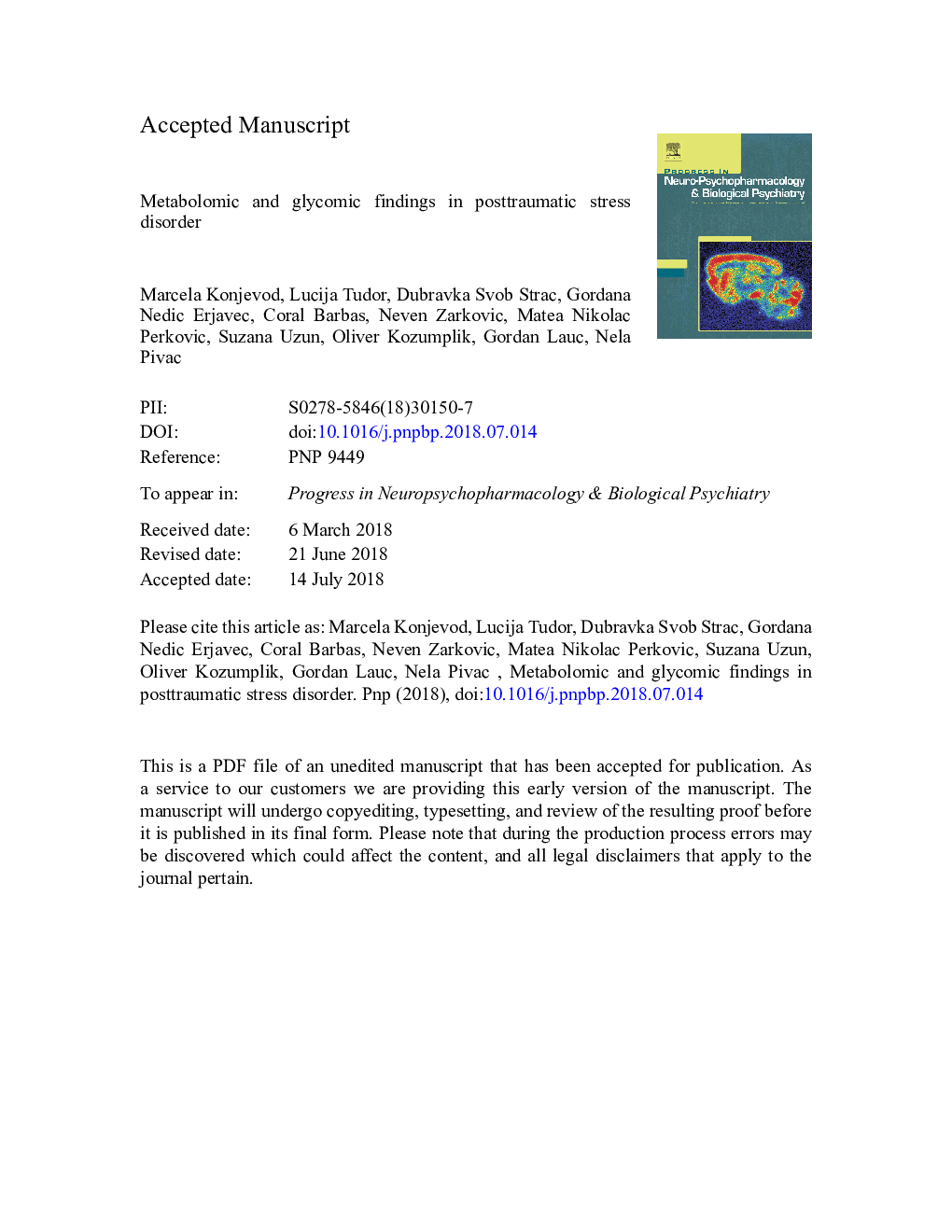| کد مقاله | کد نشریه | سال انتشار | مقاله انگلیسی | نسخه تمام متن |
|---|---|---|---|---|
| 8537179 | 1561006 | 2019 | 46 صفحه PDF | دانلود رایگان |
عنوان انگلیسی مقاله ISI
Metabolomic and glycomic findings in posttraumatic stress disorder
ترجمه فارسی عنوان
یافته های متابولومیک و گلایکمی در اختلال استرس پس از سانحه
دانلود مقاله + سفارش ترجمه
دانلود مقاله ISI انگلیسی
رایگان برای ایرانیان
کلمات کلیدی
IL-1βCRHAPCICGE-LIFDocosahexaenoateNaANADPGlcNAcPEALC-MSpalmitoylethanolamide2D-NMREPAIFN-γN-acetylaspartateLDIWeak anion-exchangeTOF-MSOPLS-DANISTNox2LC-ESI-MSUDP-GlcNAcRPLCDPAACTHIL-6ESIIgGPLS-DAnuclear magnetic resonance - رزونانس مغناطیسی هستهایGC-MS - کروماتوگرافی گازی-طیف سنج جرمیBDNF - BDNF یا فاکتور نورونزایی مشتقشده از مغز CE-MS - EC-MSTwo-dimensional NMR - NMR دو بعدیPCA - PCAROS - ROSuridine diphosphate N-acetylglucosamine - uridine Diphosphate N-acetylglucosaminePosttraumatic stress disorder - اختلال استرس پس از سانحهPTSD - اختلال استرسی پس از ضایعه روانیCapillary electrophoresis-mass spectrometry - اسپکترومتری الکتروفورز مویرگیCapillary electrophoresis - الکتروفورزمویرگیimmunoglobulin G - ایمونوگلوبولین Ginterleukin 1 beta - اینترلوکین 1 بتاinterleukin 6 - اینترلوکین 6Patients - بیمار Partial least square-discriminant analysis - تجزیه و تحلیل حداقل جزئی مربعPrincipal component analysis - تحلیل مولفههای اصلی یا PCANMR - تشدید مغناطیسی هستهای tumor necrosis factor alpha - تومور نکروز عامل آلفاClinical data - داده های بالینیDHA - دوکوساهگزائنوئیک اسیدLiquid chromatography-mass spectrometry - طیف سنجی جرم کروماتوگرافی مایعMass spectrometry - طیف سنجی جرمیbrain derived neurotropic factor - عامل مغز استخوان مغز استخوان استTNF-α - فاکتور نکروز توموری آلفاMatrix assisted laser desorption/ionization time-of-flight mass spectrometry - ماتریکس از اسپکترومتر جرمی زمان رسیدن به یخ زدن لیزر استفاده کردMALDI - مالدیMALDI-TOF-MS - مالدی TOF-MSCerebrospinal fluid - مایع مغزی نخاعیCSF - مایع مغزی نخاعیMetabolomics - متابولومیکAnimal models - مدل های حیوانیNitrogen monoxide - منوکسید نیتروژنWax - مومHPA - میلی بار یا هکتوپاسکالN-acetylglucosamine - نیتستیگلوکوزامینnicotinamide adenosine dinucleotide phosphate - نیکوتین آمید آدنوزین دینوکلئوتید فسفاتcorticotropin releasing hormone - هورمون آزاد کننده کورتیکوتروپینHILIC - هیلیکhypothalamic-pituitary-adrenal - هیپوتالاموس-هیپوفیز-آدرنالC-reactive protein - پروتئین واکنشی سیCRP - پروتئین واکنشی سی یا سی. آر. پی liquid chromatography - کروماتوگرافی مایعhigh performance liquid chromatography - کروماتوگرافی مایع با کارایی بالاreverse-phase liquid chromatography - کروماتوگرافی مایع فاز معکوسhydrophilic interaction liquid chromatography - کروماتوگرافی مایع متقاطع هیدروفیلیHPLC - کروماتوگرافی مایعی کاراGas chromatography - کروماتوگرافی گازیGas Chromatography-Mass Spectrometry - گاز کروماتوگرافی-اسپکترومتری جرمیInterferon gamma - گاما اینترفرونGlycomics - گلیکوماسReactive oxygen species - گونههای فعال اکسیژنelectrospray ionization - یونیزاسیون الکترو اسپریatmospheric pressure chemical ionization - یونیزاسیون شیمیایی جوی شیمیایی
موضوعات مرتبط
علوم زیستی و بیوفناوری
علم عصب شناسی
روانپزشکی بیولوژیکی
چکیده انگلیسی
Posttraumatic stress disorder (PTSD) is a stressor-related disorder that develops in a subset of individuals exposed to a traumatic experience. Factors associated with vulnerability to PTSD are still not fully understood. PTSD is frequently comorbid with various psychiatric and somatic disorders, moderate response to treatment and remission rates. The term “theranostics” combines diagnosis, prognosis, and therapy and offers targeted therapy based on specific analyses. Theranostics, combined with novel techniques and approaches called “omics”, which integrate genomics, transcriptomic, proteomics and metabolomics, might improve knowledge about biological underpinning of PTSD, and offer novel therapeutic strategies. The focus of this review is on metabolomic and glycomic data in PTSD. Metabolomics evaluates changes in the metabolome of an organism by exploring the set of small molecules (metabolites), while glycomics studies the glycome, a complete repertoire of glycan structures with their functional roles in biological systems. Both metabolome and glycome reflect the physiological and pathological conditions in individuals. Only a few studies evaluated metabolic and glycomic changes in patients with PTSD. The metabolomics studies in PTSD patients uncovered different metabolites that might be associated with psychopathological alterations in PTSD. The glycomics study in PTSD patients determined nine N-glycan structures and found accelerated and premature aging in traumatized subjects and subjects with PTSD based on a GlycoAge index. Therefore, further larger studies and replications are needed. Better understanding of the biological basis of PTSD, including metabolomic and glycomic data, and their integration with other “omics” approaches, might identify new molecular targets and might provide improved therapeutic approaches.
ناشر
Database: Elsevier - ScienceDirect (ساینس دایرکت)
Journal: Progress in Neuro-Psychopharmacology and Biological Psychiatry - Volume 88, 10 January 2019, Pages 181-193
Journal: Progress in Neuro-Psychopharmacology and Biological Psychiatry - Volume 88, 10 January 2019, Pages 181-193
نویسندگان
Marcela Konjevod, Lucija Tudor, Dubravka Svob Strac, Gordana Nedic Erjavec, Coral Barbas, Neven Zarkovic, Matea Nikolac Perkovic, Suzana Uzun, Oliver Kozumplik, Gordan Lauc, Nela Pivac,
